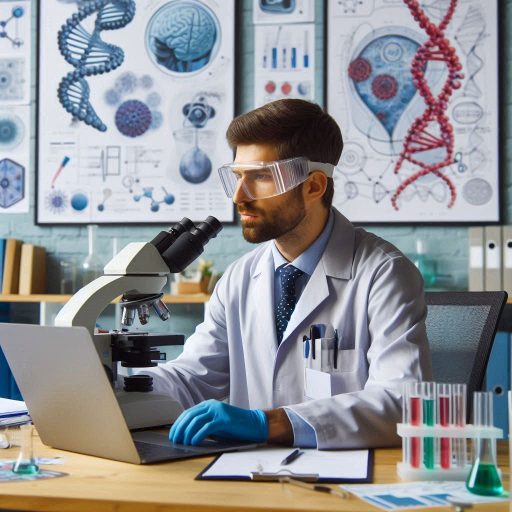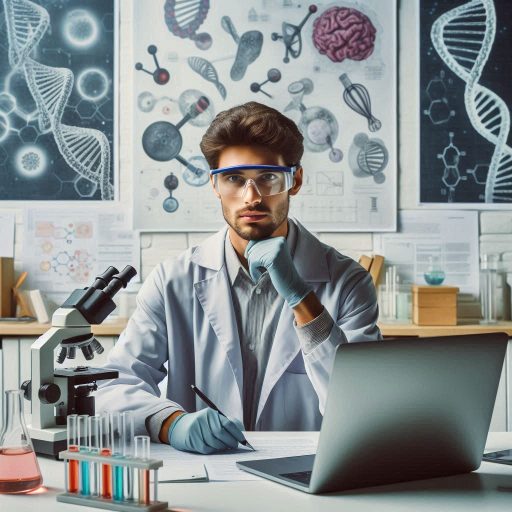Introduction
Marine biologists are dedicated scientists who focus on studying marine ecosystems and the myriad life forms they encompass.
Their work is vital to understanding the complex interactions within oceanic environments.
These researchers investigate everything from microscopic plankton to large marine mammals, exploring how various species coexist and interact with their habitats.
They analyze the health of marine organisms and ecosystems, providing valuable data that informs conservation efforts.
By studying biological diversity, ecological processes, and environmental changes, marine biologists help us comprehend the intricate web of life beneath the waves.
The importance of marine protected areas (MPAs) cannot be overstated in the realm of conservation.
These designated zones serve as safe havens for marine life, protecting critical habitats from human exploitation and environmental degradation.
MPAs are strategically established to preserve vital ecosystems, such as coral reefs, mangroves, and seagrass beds.
These areas play a crucial role in maintaining biodiversity by providing refuge for endangered species and supporting the overall health of marine environments.
Moreover, MPAs contribute to the replenishment of fish stocks, ensuring sustainable fisheries for future generations.
By allowing ecosystems to recover from the pressures of overfishing, pollution, and habitat destruction, MPAs foster resilience in marine habitats.
They also help mitigate the effects of climate change by preserving essential ecosystem services, such as carbon sequestration and coastal protection.
The collaboration between marine biologists and the management of MPAs is crucial for effective conservation strategies.
What is a Marine Biologist?
Definition of Marine Biologists
Marine biologists study ocean ecosystems, marine organisms, and their interactions.
They explore the complexities of marine life, including fish, mammals, plants, and microorganisms.
This field combines biology, ecology, and environmental science to understand oceanic environments.
Responsibilities and Duties of Marine Biologists
The responsibilities of marine biologists vary widely.
They conduct research to gather data on marine species and habitats.
This research may involve field studies, laboratory work, or both.
Marine biologists often analyze the health of marine populations and ecosystems.
They also monitor environmental changes and assess human impacts on marine life.
In addition to research, marine biologists play a crucial role in conservation efforts.
They develop strategies to protect endangered species and restore damaged habitats.
Many marine biologists collaborate with governments and organizations to create marine protected areas (MPAs).
These areas help conserve biodiversity and ensure the sustainable use of marine resources.
Marine biologists also educate the public about marine conservation issues.
They share their findings through lectures, publications, and community outreach programs.
Skills and Qualifications Needed to Become a Marine Biologist
To become a marine biologist, individuals must possess specific skills and qualifications.
A strong background in biology and environmental science is essential.
Most marine biologists hold at least a bachelor‘s degree in marine biology, biology, or a related field.
Many also pursue advanced degrees to specialize in specific areas of marine research.
Skills in data analysis and statistical methods are vital.
Marine biologists frequently use software tools to interpret research data.
Fieldwork skills, including scuba diving and boat operation, are also beneficial.
Effective communication skills are necessary for presenting research findings and collaborating with colleagues.
Problem-solving abilities are crucial in this field.
Marine biologists often face complex challenges that require innovative solutions.
They must adapt to changing environments and emerging threats to marine ecosystems.
Additionally, critical thinking skills help them analyze research findings and draw meaningful conclusions.
A passion for marine life and the ocean is essential.
A genuine interest in conservation motivates marine biologists to protect marine ecosystems.
Many spend long hours in the field, often in challenging conditions.
This dedication to understanding and preserving marine life drives their work.
Marine biologists are vital to understanding and conserving our oceans.
Their research and conservation efforts help protect marine species and habitats.
By combining education, fieldwork, and collaboration, marine biologists contribute significantly to marine science and conservation initiatives.
Aspiring marine biologists should focus on gaining relevant education, skills, and experience to succeed in this rewarding field.
Read: U.S. Cities with the Most Opportunities for Environmental Scientists
Role of Marine Biologists in Marine Protected Areas
Importance of Studying Marine Ecosystems in Protected Areas
Marine protected areas (MPAs) are crucial for the conservation of marine ecosystems.
These areas safeguard biodiversity and support the recovery of threatened species.
Studying marine ecosystems within MPAs helps scientists understand ecological processes.
This research provides insight into the dynamics of marine life and its interactions with the environment.
Marine biologists analyze how various species coexist and depend on each other.
They assess the health of coral reefs, seagrass beds, and other vital habitats.
By studying these ecosystems, marine biologists can identify changes that occur over time.
This understanding informs conservation strategies and management practices to protect these delicate environments.
Impact of Human Activities on Marine Environments
Human activities significantly impact marine environments.
Overfishing, pollution, and climate change threaten marine ecosystems and the species that inhabit them.
Marine biologists study these impacts to understand their extent and consequences.
They gather data on how pollution affects water quality and marine life.
This research reveals the detrimental effects of plastic waste, chemical runoff, and noise pollution.
Additionally, marine biologists examine the consequences of habitat destruction, such as coral bleaching and loss of biodiversity.
Understanding these impacts is essential for developing effective conservation measures.
How Marine Biologists Contribute to the Management and Conservation of Marine Protected Areas
Marine biologists play a vital role in the management and conservation of MPAs.
They collaborate with policymakers and conservation organizations to develop management plans.
These plans often include strategies for sustainable resource use and habitat restoration.
By conducting research, marine biologists provide valuable data to inform decision-making.
They assess the effectiveness of existing MPAs and recommend necessary adjustments.
Their expertise guides the creation of new protected areas based on ecological needs.
Marine biologists also engage in community outreach and education.
They help raise awareness about the importance of MPAs and their role in preserving marine life.
By educating local communities, they promote stewardship and responsible behavior toward marine resources.
Monitoring is another critical function of marine biologists.
They regularly assess the health of marine ecosystems within MPAs.
This monitoring helps track changes in biodiversity and environmental conditions.
Through data collection and analysis, marine biologists can identify trends and threats.
This ongoing assessment allows for timely interventions to address emerging issues.
In short, marine biologists are essential to the success of marine protected areas.
Their research and management efforts help conserve marine ecosystems and protect biodiversity.
By understanding the impacts of human activities, marine biologists can develop strategies to mitigate these effects.
Their contributions ensure the sustainability of marine resources for future generations.
Read: Environmental Scientist vs. Ecologist: Roles and Differences in the US
Benefits of Marine Protected Areas
Preservation of Biodiversity and Ecosystems
Marine protected areas (MPAs) play a critical role in preserving biodiversity and maintaining healthy ecosystems.
These areas provide safe havens for a wide variety of marine life, allowing species to thrive without the pressures of overfishing and habitat destruction.
By restricting human activities, MPAs help maintain the balance of marine ecosystems.
Healthy ecosystems contribute to the resilience of marine life, enabling species to adapt to environmental changes.
Diverse habitats, such as coral reefs, mangroves, and seagrass beds, support various organisms, from tiny plankton to large marine mammals.
Protecting these habitats ensures the survival of numerous species and the intricate web of life they support.
Protection of Endangered Species
MPAs are vital for the protection of endangered species.
Many marine species, such as sea turtles, sharks, and certain fish populations, face significant threats from fishing, pollution, and climate change.
By establishing MPAs, governments and conservation organizations can create safe environments for these vulnerable species.
Within MPAs, breeding and feeding grounds remain undisturbed.
This protection allows endangered species to reproduce and increase their populations.
Marine biologists monitor these populations to assess recovery efforts and ensure that conservation strategies are effective.
Additionally, MPAs can help mitigate the impacts of climate change.
Healthy ecosystems are better equipped to adapt to changing conditions, such as rising sea temperatures and ocean acidification.
Protecting these areas fosters resilience, enabling endangered species to survive and thrive in the face of challenges.
Sustainability of Fisheries and Marine Resources
Sustainable fisheries are essential for both ecological balance and human livelihoods.
MPAs contribute to the sustainability of fisheries by allowing fish populations to recover and grow.
When fishing is restricted in protected areas, fish can reproduce and increase their numbers.
This leads to healthier populations that can spill over into adjacent fishing zones.
By managing fish stocks effectively, MPAs support local economies and food security.
Healthy fish populations ensure a steady supply of seafood for communities that rely on fishing for their livelihoods.
Additionally, MPAs can enhance the resilience of fisheries against environmental changes, making them more sustainable in the long term.
Moreover, MPAs can serve as a valuable resource for scientific research and education.
They provide unique opportunities to study marine ecosystems and monitor the effects of protection measures.
This research informs best practices for sustainable fishing and conservation strategies.
Marine protected areas offer numerous benefits, including the preservation of biodiversity and ecosystems, protection of endangered species, and sustainability of fisheries and marine resources.
By safeguarding these vital areas, we ensure the health and resilience of our oceans.
The establishment and management of MPAs are crucial for the long-term well-being of marine life and the communities that depend on it.
Read: The Relationship Between U.S. Policy & Environmental Scientist Roles

Uncover the Details: Future Trends in Meteorology: What’s on the Horizon?
Challenges Faced by Marine Biologists in Marine Protected Areas
Climate Change and Its Effects on Marine Ecosystems
Marine biologists face significant challenges due to climate change.
Rising ocean temperatures threaten the delicate balance of marine ecosystems.
Species that rely on specific temperature ranges may struggle to survive as their habitats shift.
Coral reefs, in particular, are highly sensitive to temperature changes.
Increased temperatures can lead to coral bleaching, a process that weakens these vital ecosystems.
Ocean acidification, another consequence of climate change, poses additional risks.
As carbon dioxide levels rise, oceans absorb more CO2, leading to decreased pH levels.
This change negatively affects shell-forming organisms, such as mollusks and corals.
Marine biologists study these impacts to understand how ecosystems may adapt or decline.
Their research helps inform conservation strategies to mitigate these effects.
Pollution and Its Impact on Marine Life
Pollution presents another significant challenge for marine biologists.
Various pollutants, including plastics, heavy metals, and chemicals, adversely affect marine ecosystems.
Plastic waste, in particular, poses a severe threat to marine life.
Sea turtles and marine mammals often ingest plastic debris, mistaking it for food.
This ingestion can lead to injury, starvation, or even death.
Chemical pollutants, such as pesticides and fertilizers, can contaminate marine habitats.
Runoff from agriculture introduces harmful substances into oceans, disrupting ecosystems.
Marine biologists monitor the impacts of pollution on marine life, studying how it affects health, reproduction, and behavior.
Their findings are crucial for developing effective management strategies to reduce pollution in MPAs.
Overfishing and Unsustainable Fishing Practices
Overfishing remains a critical issue affecting marine protected areas.
Despite the establishment of MPAs, illegal and unsustainable fishing practices continue to threaten marine life.
Overfishing depletes fish populations, disrupting the balance of ecosystems and threatening the survival of numerous species.
Marine biologists work to combat these challenges by conducting research on fish populations and their habitats.
They assess the effectiveness of fishing regulations and advocate for sustainable practices.
Collaborating with local communities and fishermen, they promote responsible fishing methods that protect marine resources.
Despite their efforts, enforcement of fishing regulations can be challenging.
Many MPAs lack adequate resources for monitoring and enforcement, allowing illegal fishing to persist.
Marine biologists advocate for increased funding and support for effective management to ensure the success of MPAs.
In summary, marine biologists face various challenges in marine protected areas, including climate change, pollution, and overfishing.
Their work is essential for understanding these issues and developing effective strategies for conservation.
Addressing these challenges requires collaboration among scientists, policymakers, and local communities to protect marine ecosystems and ensure the sustainability of marine life.
Through continued research and advocacy, marine biologists strive to overcome these obstacles and promote the health of our oceans.
Read: Organizations & Associations for Environmental Scientists in the USA
See Related Content: How to Become a Hydrologist: Steps and Requirements
Case Studies of Successful Marine Protected Areas
Examples of Marine Protected Areas Around the World
Marine protected areas (MPAs) exist globally, showcasing successful conservation efforts.
One notable example is the Great Barrier Reef Marine Park in Australia.
Established in 1975, it spans over 344,000 square kilometers.
This MPA aims to protect the world‘s largest coral reef ecosystem, supporting diverse marine species and habitats.
Another successful MPA is the Papah?naumoku?kea Marine National Monument in Hawaii.
Designated in 2006, it covers approximately 1.5 million square kilometers.
This area is home to many endangered species and culturally significant sites.
The monument protects various marine ecosystems, including coral reefs and deep-sea habitats.
In the Mediterranean, the Port-Cros National Park in France serves as another success story.
Established in 1963, it focuses on protecting marine biodiversity and enhancing ecosystem resilience.
The park has implemented effective management strategies that promote sustainable tourism and fishing practices.
Transform Your Career Today
Unlock a personalized career strategy that drives real results. Get tailored advice and a roadmap designed just for you.
Start NowImpact of Conservation Efforts on Marine Ecosystems
Conservation efforts within these MPAs have led to significant improvements in marine ecosystems.
The Great Barrier Reef, for example, has experienced increased fish populations and improved coral health since the establishment of protective measures.
By restricting fishing and other harmful activities, the park has allowed ecosystems to recover and thrive.
In Papah?naumoku?kea, conservation efforts have resulted in the protection of key habitats and endangered species.
Research conducted in the area shows a positive trend in the population of green sea turtles and Hawaiian monk seals.
These species benefit from the protections afforded by the MPA, highlighting the effectiveness of conservation strategies.
Port-Cros National Park has seen similar successes.
Studies show increased biodiversity and improved ecosystem health due to restricted fishing and habitat restoration efforts.
The park‘s management practices have fostered a more resilient marine environment, which benefits both wildlife and local communities.
Success Stories of Restored Marine Environments
Several inspiring success stories illustrate the positive impact of MPAs on marine environments.
The Tubbataha Reefs Natural Park in the Philippines is a prime example.
Established in 1993, this UNESCO World Heritage site has witnessed remarkable recovery in coral cover and fish populations.
Strict enforcement of regulations has allowed ecosystems to rebound, attracting divers and ecotourism opportunities.
In the United States, the Channel Islands National Marine Sanctuary off California‘s coast has also experienced significant recovery.
Since the establishment of protections in 2003, studies have shown increased abundance and diversity of marine species.
The sanctuary‘s success has prompted discussions about expanding protections in other coastal areas.
The Kona coast of Hawaii serves as another success story.
Following the implementation of community-led conservation efforts, the area has seen an increase in fish populations and improved coral health.
Local fishermen have embraced sustainable practices, demonstrating the power of community involvement in conservation.
Case studies of successful marine protected areas highlight the positive impact of conservation efforts on marine ecosystems.
Examples from around the world demonstrate the effectiveness of MPAs in restoring marine environments.
These success stories inspire continued commitment to protecting our oceans, ensuring the health of marine ecosystems for future generations.
Gain More Insights: Education Pathways for Aspiring Archaeologists
Uncover the Details: Virologist vs. Microbiologist: What’s the Difference?
You Might Also Like: Latest Advancements in Nanomaterials Research
Conclusion
In studying Marine Protected Areas, marine biologists play a crucial role by conducting research and monitoring marine ecosystems.
They help in assessing the health of marine habitats and the biodiversity of species within these protected areas.
Through their studies, marine biologists provide valuable insights into the impacts of human activities on marine environments.
Their research helps in developing effective conservation strategies and management plans for these areas.
By understanding the dynamics of marine ecosystems, marine biologists can identify threats and propose solutions for their protection.
Marine biologists are essential for the preservation of marine protected areas and the conservation of marine biodiversity.
It is crucial to support and fund their research efforts to ensure the sustainable management of marine ecosystems.
We all have a responsibility to protect our oceans and the creatures that inhabit them, and marine biologists play a vital role in this mission.
Let us join hands in supporting marine conservation efforts and working towards a healthier and more sustainable marine environment.




